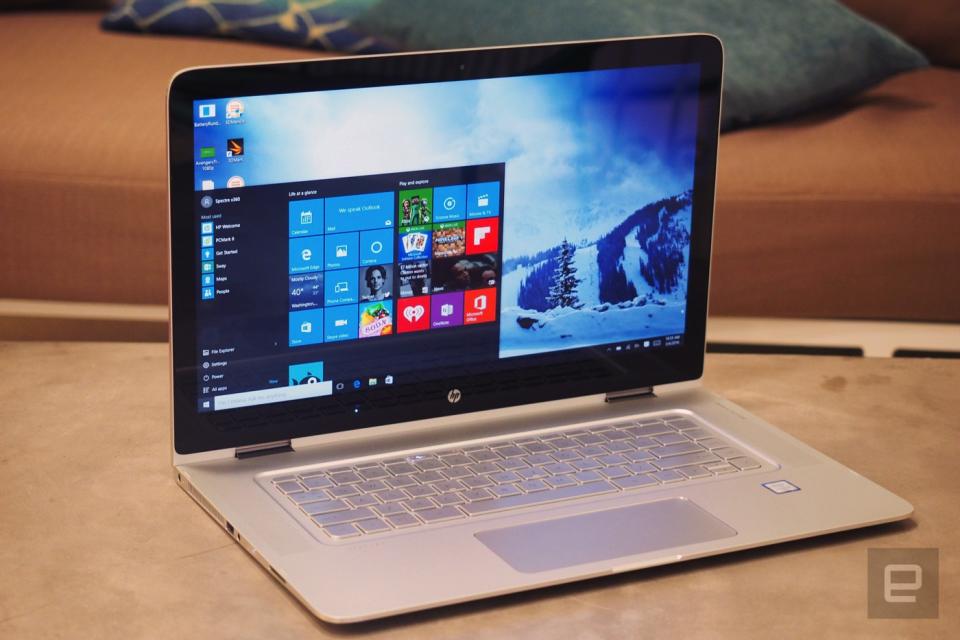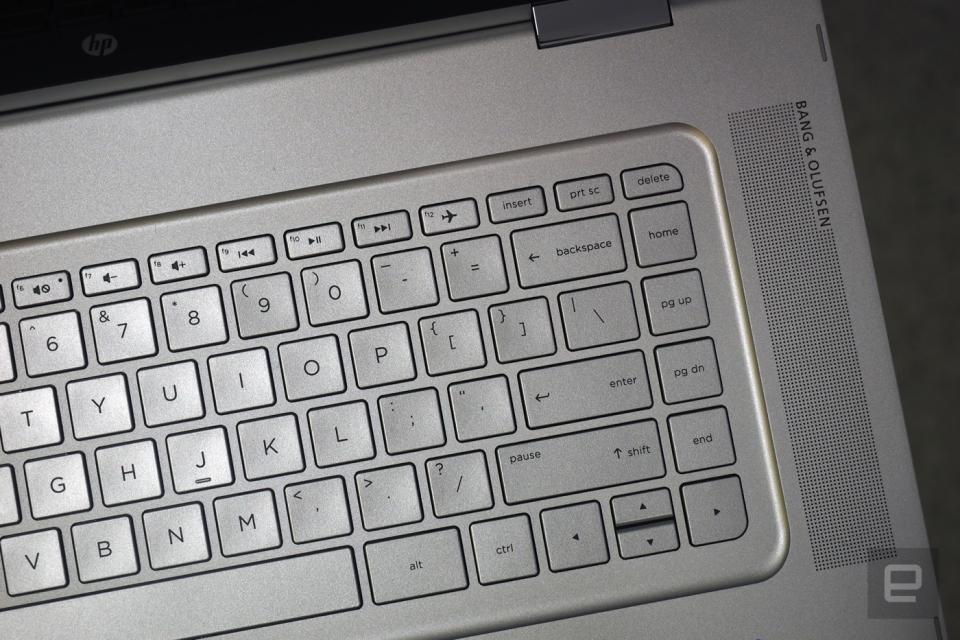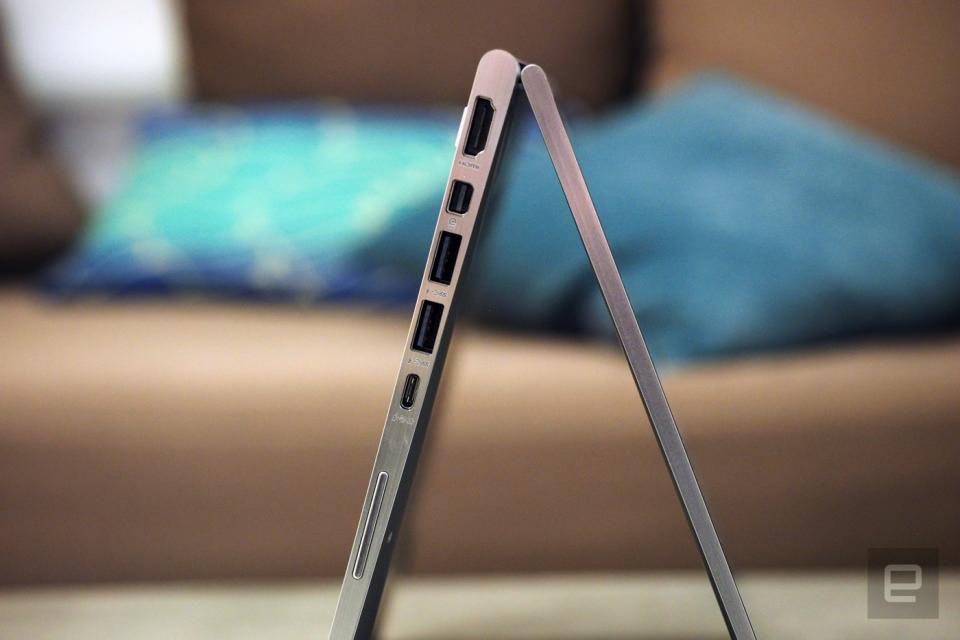HP's 15-inch Spectre x360: Come for the screen, stay for the battery life
One of our favorite laptops is now available with a larger, 4K-optional display.

Before there was a Surface Book, there was the Spectre x360. Though the laptop is sold by HP and has HP's name on it, it was designed in close collaboration with Microsoft, which had input on everything from the touchpad to the WiFi radio. The result was a beautiful, well-performing machine with one clean Windows build -- and it gave us an early glimpse at what Microsoft could accomplish when it set about designing a laptop. The 13-inch x360 was one of our favorite laptops of 2015, and now HP is back with a larger model. The 15-inch version ($1,150 and up) promises to be everything its little brother was, complete with a 360-degree touchscreen and the same unibody aluminum design. Except, you know, it offers more screen real estate, along with a higher-res 4K option. And with it weighing in at four pounds, you'll be hard-pressed to find something this size that's this thin and light.
Hardware

True to its name, the 15-inch Spectre x360 is a bigger version of the 13-inch model that we tested last year. Like the smaller edition, it has a beautiful machined aluminum body with rounded corners, blunt edges and a 360-degree lie-flat hinge that makes the machine look equally thin regardless of whether it's in clamshell or tablet mode. The keys are also made of metal and are as well spaced as you'd expect on a machine with this large a footprint. Though the buttons look shallow for a laptop this size, in practice they're comfortable to type on, not to mention quiet. To match, there's an extra-wide, single-button trackpad that gave me ample space to move around but could be a little flaky, even with single-finger tracking. Hopefully HP can fix that through a firmware update.
What you might not expect, though, is how light the thing is. Typically I dread reviewing 15-inch machines because I know they'll weigh down my bag and take up a lot of space on my desk. I can't do much about the larger footprint in this case, but at 4.05 pounds, it's definitely easier to tote around than other 15-inch systems. The x360 is also thinner than I would have guessed, at 0.63 inches thick. That won't save me space on my desk, but it at least makes it that much easier to hold the machine in hand.

Though the 15-inch model has a bigger footprint, it barely offers more ports along its edges. Like its smaller stablemate, it includes three USB 3.0 connections, a Mini DisplayPort, an HDMI socket, an SD card reader, a headphone jack and a volume rocker, for use in tablet mode. The only other thing you'll get here is a smaller USB Type-C port -- an important addition, considering how ubiquitous the standard is getting. In fact, I wouldn't be surprised if HP added it on the 13-inch edition too.
Display and sound

One of the main things separating the 15-inch Spectre x360 from the 13-inch version is its optional 3,840 x 2,160 display. Unfortunately, the unit I tested had a lower-res 1,920 x 1,080 panel, so we're going to have to trust that the 4K display is as sharp and pixel-dense as the 4K displays on every other 15-inch laptop. (I believe it is.) The real shame there is that I would have liked to know how the battery fares when forced to light up those extra pixels, though I can at least attest to the machine having good runtime at 1080p (more on that later).
Even with that lower resolution, I still enjoyed looking at the display. Setting aside the fact that 1080p is actually gentle on my not-so-good eyes, the colors are pleasant and the IPS panel allowed for wide enough viewing angles that I could spend hours working next to a window on a sunny day. Is it the sharpest, most color-accurate laptop screen money can buy? Hardly. But your eyestrain will be kept to a minimum, and, if you're like me, you'll enjoy the extra screen real estate when you're working in a spreadsheet or jumping among a dozen browser tabs.

Apple's acquisition of Beats meant HP had to team up with a new audio company to power its speakers. It landed on Bang & Olufsen, which previously provided its know-how to other PC makers like ASUS. I'd say that although HP didn't necessarily plan on parting ways with Beats, it definitely traded up. The sound coming out of the grilles on either side of the keyboard is balanced and not too bass heavy.
Performance and battery life
PCMark 7 | PCMark 8 (Creative Accelerated) | 3DMark 11 | 3DMark (Sky Diver) | ATTO (top reads/writes) | |
|---|---|---|---|---|---|
HP Spectre x360 15t (2.4GHz Core i5-6200U, Intel HD 520) | 5,040 | 3,458 | E2,672 / P1,526 / X420 | 3,542 | 561 MB/s / 284 MB/s |
Razer Blade Stealth (2.5GHz Intel Core i7-6500U, Intel HD 520) | 5,131 | 3,445 | E2,788 / P1,599 / X426 | 3,442 | 1.5 GB/s / 307 MB/s |
Toshiba Radius 12 (2.5GHz Intel Core i7-6500U, Intel HD 520) | 5,458 | 3,684 | E2,865 / P1,622 | 3,605 | 552 MB/s / 489 MB/s |
HP Spectre x2 (1.2GHz Core M7-6Y75, Intel HD 515) | 3,395 | 3,307 | E1,884 / P1,148 / X331 | 2,737 | 554 MB/s / 281 MB/s |
Microsoft Surface Pro 4 (2.4GHz Core i5-6300U, Intel HD 520) | 5,403 | 3,602 | E2,697/ P1,556/ X422 | 3,614 | 1.6 GB/s / 529 MB/s |
Lenovo Yoga 900 (2.5GHz Core i7-6500U, Intel HD 520) | 5,368 | 3,448 | E2,707 / P1,581 | 3,161 | 556 MB/s / 511 MB/s |
Microsoft Surface Book (2.4GHz Core i5-6300U, Intel HD 520) | 5,412 | 3,610 | E2,758 / P1,578 / X429 | 3,623 | 1.6 GB/s / 571 MB/s |
Microsoft Surface Book (2.6GHz Core i7-6600U, 1GB NVIDIA GeForce graphics) | 5,740 | 3,850 | E4,122 / P2,696 | 6,191 | 1.55 GB/s / 608 MB/s |
For the purposes of this review, I tested the entry-level $1,150 model, which has a dual-core 2.4GHz Intel Core i5-6200U processor, 8GB of RAM, integrated Intel 520 graphics and a 256GB solid-state drive. You'll find similar specs in many smaller PCs, including Microsoft's Surface Pro 4 and some lower-end Surface Book configurations, among others. And it performs about the same too, both in benchmarks and in real-world use. Unlike competing notebooks, though, the x360 comes with a near-blank Windows 10 install, with little bloatware in sight. Just shortcuts to Netflix, Snapfish and a handful of HP-made programs, like HP ePrint. Not bad at all.
In my time with the x360, I treated it as a work-and-play machine, which means I was typically juggling nine pinned tabs in Chrome (plus lots of open ones), Slack, Spotify and intermittent file downloads. The machine boots into the desktop in 11 seconds, which is on par with other modern laptops. The Lite-On-made SSD can read data with the best of them too, notching average max speeds of 561 megabytes per second. That said, you'd absolutely get faster writes if this were a PCIe-based drive, specifically.
Aside from sheer processing power, I was impressed by the Intel-made 2x2 802.11ac wireless radio. I enjoyed a reliable connection even on what should have been slow, spotty networks. During jury duty, for instance, I had no problems on the public WiFi network that hundreds of other people were using -- and that people around me were complaining about. I managed to get online anyway.
Throughout, the laptop stayed cool. I should know: While serving jury duty, I spent my days with the machine on my lap getting work done. I may have lost my patience, but my legs at least avoided any contact burns.
Battery life | |
|---|---|
HP Spectre x360 (15-inch, early 2016) | 10:17 |
Surface Book (Core i5, integrated graphics) | 13:54 / 3:20 (tablet only) |
MacBook Air (13-inch, 2013) | 12:51 |
HP Spectre x360 (13-inch, 2015) | 11:34 |
Surface Book (Core i7, discrete graphics) | 11:31 / 3:02 (tablet only) |
Apple MacBook Pro with Retina display (13-inch, 2015) | 11:23 |
iPad Pro | 10:47 |
Chromebook Pixel (2015) | 10:01 |
Lenovo Yoga 900 | 9:36 |
Microsoft Surface 3 | 9:11 |
Apple MacBook (2015) | 7:47 |
Dell XPS 13 (2015) | 7:36 |
Microsoft Surface Pro 4 | 7:15 |
Microsoft Surface Pro 3 | 7:08 |
HP Spectre x2 | 6:43 |
Razer Blade Stealth | 5:48 |
Toshiba Radius 12 | 5:12 |
HP says the machine's 64.5Wh battery should run for up to nine and a half hours on a charge. I can't speak for the 4K edition, but the lower-res 1080p model I tested actually beat that estimate, lasting exactly 10 hours and 17 minutes before giving up the ghost. Mind you, that was with an HD video looping, WiFi on and the brightness fixed at 65 percent. With a less taxing workload, you might be able to eke out even more runtime. Even as is, though, 10-plus hours is more than respectable for a modern laptop, though it must be said that the 13-inch version we tested a year ago lasted even longer.
As a bonus, when you do need the charger here, it takes up remarkably little space -- it's just a small, lightweight cube. Anyway, that's not a dealmaker by any means but something to consider if you're worried about the weight and footprint of a 15-inch machine; the space you'd save with a 13-inch laptop might be offset somewhat by its bulkier power brick.
Configuration options and the competition

The 15-inch x360 starts at $1,150 with a 2.3GHz dual-core Core i5-6200U processor, integrated Intel HD 520 graphics, 8GB of RAM, a 256GB solid-state drive and a 1080p display. From there, you can get 16GB of RAM ($80), upgrade to a 4K screen ($60) or double the storage capacity to 256GB ($200). There are other processor options too, including Core i7-6500U ($60) and Core i7-6560U ($200), the latter of which includes beefier Intel Iris graphics. If you care, that in-between Core i7-6500U chip can be configured with either 8GB or 16GB of RAM while the higher-end 6560U processor is 16GB only. All told, assuming you went with all the upgrade options I just ticked off, the price would be $1,690 before tax.

If you're shopping around, the 15-inch Retina MacBook Pro is an obvious competitor here, in that it's also a slim, lightweight 15-inch machine with a high-res screen (2,880 x 1,800 in this case). Incidentally, it's actually thicker and heavier than the x360 (4.49 pounds and 0.71 inches thick), and that's without a 360-degree hinge or touchscreen weighing it down. For that starting price of $1,999, though, you get some admittedly more powerful components, including a quad-core Core i7 processor and Intel Iris graphics, with 16GB of RAM and 256GB of solid-state storage standard. From there, you can add a discrete AMD GPU or a faster CPU, but even on the base model the trade-off is clear: Though it's heavier and more expensive than the x360 and isn't as versatile as a convertible, you get more-robust performance in return. Your call on what's most important.
Back in the world of Windows PCs, there aren't that many laptops that directly compete with the 15-inch Spectre x360, but I can think of at least two that might fit the bill. The first is the Dell XPS 15, which also has a 15-inch, 4K-optional display and starts at a similar 3.9 pounds. (With a tapered design that runs between 0.45 and 0.66 inches thick, it's also thinner at points, too.) Though it starts at $1,000, the specs you get for that price don't compete at all with the Spectre x360 we're looking at today. The base model includes a Core i3 processor, 8GB of RAM, a non-touch 1080p screen and a 500GB hybrid hard drive.
But say you just wanted a touchscreen. The cheapest touch-enabled model on offer starts at $1,999 and also entails a big step up in specs, including a 4K screen, a quad-core Core i7 processor, 16GB of memory and a 2GB NVIDIA GTX 960M GPU. Basically, then, there's no in-between option, where you can get a Core i5 processor, or a touchscreen, with a lower resolution. With the XPS 15, Dell makes up-sells almost unavoidable; the specs you're likely to pick are more in line with a souped-up MacBook Pro. That's not a bad thing, but it's no doubt more money than some of you were planning on spending.
Last, there's Microsoft's Surface Book ($1,499 and up), though that's a less perfect comparison, mostly because it has a smaller 13.5-inch screen, not a 15-inch one. That said, its high-res, 3,000 x 2,000 display and slim, versatile design (it's a detachable tablet) make it a possible contender. As do its specs: Certain high-end configurations have a discrete NVIDIA GPU in the detachable keyboard portion, allowing for likely stronger performance than what the Spectre x360 is currently capable of.
As a warning, some early units were plagued by hardware and software issues, but Microsoft claims to have addressed them through a series of firmware updates. It's likely, then, that early adopters got the shortest end of the stick, but it's worth considering anyway before plunking down all that money.
Wrap-up

The 15-inch Spectre x360 is a bigger, but not necessarily more powerful, version of the original that came out last year. The main benefit is extra screen real estate and, if your budget allows, the optional 4K resolution. Even at its best, though, the 15-inch x360 has similar specs to many 13-inch notebooks; that extra heft doesn't translate to extra processing clout or longer battery life. If all you want is a bigger screen that's easier on the eyes while you're working for long stretches, the 15-inch x360 is well-constructed and compact for its size.
Personally, that's not what I'm looking for in a laptop, but I'm sure there are people out there who are in the market for a bigger-screened thin-and-light. (If it helps, Dell says the XPS 15 is outselling the XPS 13, so I know for sure that that's the case.) If, however, you need some performance muscle to match your higher-res screen, you'll need to pay more for a machine with meatier specs, like the Dell XPS 15 or the MacBook Pro. It all depends on your priorities.






































